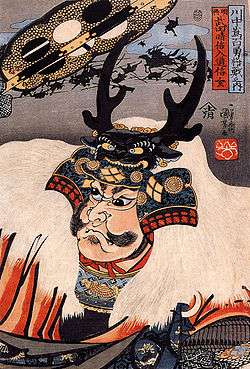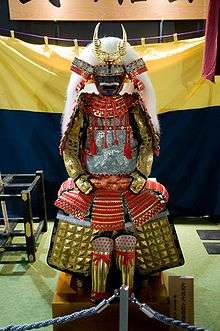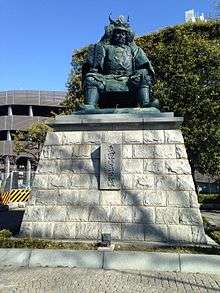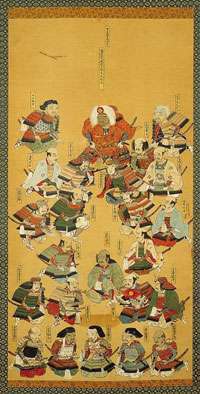Takeda Shingen
| Takeda Shingen | |
|---|---|
 | |
| Native name | 武田 信玄 |
| Nickname(s) | Tiger of Kai |
| Born |
December 1, 1521 Kai Province, Japan |
| Died |
May 13, 1573 (age 51) Mikawa Province, Japan |
| Allegiance | Takeda family |
| Rank | Lord (Daimyō) |
| Battles/wars | |
Takeda Shingen (武田 信玄, December 1, 1521 – May 13, 1573), of Kai Province, was a pre-eminent daimyo in feudal Japan with exceptional military prestige in the late stage of the Sengoku period.[1]
Name

Shingen was called "Tarō" (a commonly used pet name for the eldest son of a Japanese family) or Katsuchiyo (勝千代) during his childhood. When he celebrated his coming of age, he was given the formal name Harunobu (晴信), which included a character from the name of Ashikaga Yoshiharu (足利義晴), the 12th Ashikaga Shogun. It was a common practice in feudal Japan for a higher-ranked warrior to bestow a character from his own name to his inferiors as a symbol of recognition. From the local Lord's perspective, it was an honour to receive a character from the shogunate, although the authority of the latter had greatly degenerated in the mid-16th century.
Both the Ashikaga and the Takeda clans descended from the Minamoto (源) clan. Technically, Harunobu, as well as his forefathers, had borne the surname of Minamoto. Therefore, Harunobu would be referred to as "Minamoto-no Harunobu" (源晴信) in official records kept by the Imperial Court when he was conferred the official title of "Daizen Dayu" (大膳大夫). The Imperial Court had maintained a system of ritsuryō (律令) that was parallel to the shogunate apparatus.
In 1551 Harunobu chose to live a pabbajja life and received a dharma name, Shingen (信玄), from his Buddhist master.[2] The kanji of "Shingen" can also be pronounced as "Nobuharu," which is the inversion of his official name, Harunobu. In ancient times, such religious names of recognized Japanese aristocrats would be read in "on'yomi" (音読み), the Chinese-style pronunciation, instead of "kun'yomi" (訓読み), the indigenous Japanese pronunciation. Although widely known by the dharma name, Takeda Shingen's formal name remained "Harunobu" throughout the rest of his life.
Shingen is sometimes referred to as "The Tiger of Kai" (甲斐の虎) for his martial prowess on the battlefield. His primary rival, Uesugi Kenshin (上杉謙信), was often called "The Dragon of Echigo" (越後の龍) or also "The Tiger of Echigo" (越後の虎).
"These two seemed to have enjoyed meeting in battle." They fought several times at Kawanakajima.[3]
Early life

Takeda Shingen was the first-born son of Takeda Nobutora (武田信虎), leader of the Takeda clan, and daimyo of the province of Kai. He had been an accomplished poet in his youth. He assisted his father with the older relatives and vassals of the Takeda family, and became quite a valuable addition to the clan at a fairly young age. In 1536, at the age of 15, he was instrumental in helping his father win the Battle of Un no Kuchi.[4][5]
At some point in his life after his "coming of age" ceremony, the young man decided to rebel against Nobutora. He finally succeeded in 1540, successfully taking control of the clan. Events regarding this change of leadership are not entirely clear, but it is thought that Nobutora had planned to name the second son, Nobushige, as his heir instead of Shingen. The end result was a miserable retirement that was forced upon him by Shingen and his supporters: he was sent to Suruga Province, on the southern border of Kai, to be kept in custody under the scrutiny of the Imagawa clan, led by his son-in-law Imagawa Yoshimoto (今川義元), the daimyo of Suruga. For their help in this bloodless coup, an alliance was formed between the Imagawa and the Takeda clans.[1]
Initial expansion
Shingen's first act was to gain a hold of the area around him. His goal was to conquer Shinano Province (信州). A number of the major warlords in the Shinano region marched on the border of Kai Province, hoping to neutralize the power of the still-young Shingen before he had a chance to expand into their lands. However, planning to beat him down at Fuchu (where word had it Shingen was gathering his forces for a stand), they were unprepared when Takeda forces suddenly came down upon them at the Battle of Sezawa. Taking advantage of their confusion, Shingen was able to win a quick victory, which set the stage for his drive into Shinano lands that same year and his successful Siege of Uehara. The young warlord made considerable advances into the region, conquering the Suwa headquarters in the Siege of Kuwabara before moving into central Shinano with the defeat of both Tozawa Yorichika and Takato Yoritsugu in the Siege of Fukuyo and Battle of Ankokuji. In 1543, he captured Nagakubo castle, Kojinyama in 1544, and then Takato and Ryugasaki in 1545. In 1546 he took Uchiyama and won the Battle of Odaihara. In 1547, he took Shika. However, the warlord was checked at Uedahara by Murakami Yoshikiyo, losing two of his generals in a heated battle which Murakami won. Shingen managed to avenge this loss and the Murakami clan was eventually defeated in the Sieges of Toishi. Murakami fled the region, eventually coming to plead for help from the Province of Echigo (越後).
In 1548, Shingen defeated Ogasawara Nagatoki in the Battle of Shiojiritoge and then took Fukashi in 1550.[4]

After conquering Shinano, Shingen faced another rival, Uesugi Kenshin of Echigo. The feud between them became legendary, and they faced each other on the battlefield five times in the Battles of Kawanakajima. These battles were generally confined to controlled skirmishes, neither daimyo willing to devote himself entirely to a single all-out attempt. The conflict between the two that had the fiercest fighting, and might have decided victory or defeat for one side or the other, was the fourth battle, during which the famous tale arose of Uesugi Kenshin's forces clearing a path through the Takeda troops and Kenshin engaging Shingen in single combat. The tale has Kenshin attacking Shingen with his sword while Shingen defends with his iron war fan or tessen. Both lords lost many men in this fight, and Shingen in particular lost two of his main generals, Yamamoto Kansuke and his younger brother Takeda Nobushige.[4]:269–272
After the fourth battle of Kawanakajima, the Takeda clan suffered two internal setbacks. Shingen uncovered two plots on his life, the first from his cousin Suwa Shigemasa (whom he ordered to commit seppuku), and the second, a few years later, from his own son Takeda Yoshinobu (武田義信). His son was confined to the Toko temple, where he died two years later; it is not known whether his death was natural or ordered by his father. After this incident, Shingen designated his fourth son, Takeda Katsuyori (武田勝頼), as the acting leader of the clan after himself until Katsuyori's son came of age. Katsuyori himself, however, never became the formal head of the clan.
In 1553, he captured Katsurao, Wada, Takashima and Fukuda. In 1554 he took Fukushima, Kannomine, Matsuo and Yoshioka.[4]:212–213
In 1563, allied with Hojo Ujiyasu, he captured Matsuyama Castle in Musashi Province. Takeda Shingen then took Kuragano in 1565 and Minowa Castle. He then moved against the Hojo by attacking Hachigata Castle then engaged in the Siege of Odawara (1569). He successfully withdrew after Hojo Ujiteru and Hojo Ujikuni failed to stop him in the Battle of Mimasetoge.[4]:216–218
The death of Yoshinobu is believed to have much to do with the change in Shingen's Imagawa policy. After Imagawa Yoshimoto's death in a battle against Oda Nobunaga (織田信長) in 1560, Shingen had started to plan an invasion of Suruga, a territory now controlled by Yoshimoto's son Ujizane. Yoshinobu, however, had strongly opposed such a plan because his wife was the daughter of late Yoshimoto. By 1567, nonetheless, after Shingen had successfully kept the forces led by Uesugi Kenshin out of the northern boundaries of Shinano, taken over a strategically important castle in western Kōzuke, and suppressed internal objection to his plans to take advantage of the weakened Imagawa clan, he was ready to carry out his planned Suruga invasion.
During this time Shingen also ordered the damming project of the Fuji River, which was one of the major domestic activities of the time.
Shingen and Tokugawa Ieyasu (徳川家康) "came to terms" and occupied the "former Imagawa territory."[3]:279 They both fought against Yoshimoto's heir, Imagawa Ujizane. After defeating the intervention forces commanded by Hōjō Ujimasa (北條氏政) of Sagami, Shingen finally secured the Suruga, formerly base of the prestigious Imagawa clan, as a Takeda asset in 1569.
Upon securing Takeda control over Suruga, northern Shinano, and western Kōzuke, Shingen moved to challenge the Oda-Tokugawa alliance, leading a formidable force of over 30,000 into the latter's territories in Tōtōmi, Mikawa, and Mino in 1572.
Death

The exact circumstances surrounding Takeda Shingen's death are not absolutely known. There are many different stories, some of which are as follows.
When Takeda Shingen was 49 years old, he was the only daimyo with the necessary power and tactical skill to stop Oda Nobunaga's rush to rule Japan. He engaged Tokugawa Ieyasu's forces in 1572 and captured Futamata, and in January engaged in the Battle of Mikatagahara, where he defeated, but not decisively, a small combined army of Nobunaga and Ieyasu. After defeating Tokugawa Ieyasu, Shingen stopped his advance temporarily due to outside influences, which allowed the Tokugawa to prepare for battle again. He entered Mikawa Province, but soon died in the camp. Some accounts say he succumbed to an old war wound, some say a sniper wounded him earlier, and some accounts say he died of pneumonia.[6][7] He was buried at Erin temple in what is now Kōshū, Yamanashi.[8][9]
The film Kagemusha, by director Akira Kurosawa, loosely depicts a well-known version of his death in which a single sniper shot him at night. The other aspects of his death depicted in the film were artistic liberties taken by the director.
After death
Takeda Katsuyori became the daimyo of the Takeda clan. Katsuyori was ambitious and desired to continue the legacy of his father. He moved on to take Tokugawa forts. However an allied force of Tokugawa Ieyasu and Oda Nobunaga dealt a crushing blow to the Takeda in the Battle of Nagashino. Here Oda Nobunaga's matchlock-armed infantry destroyed the Takeda cavalry. Ieyasu seized the opportunity and defeated the weak Takeda led by Takeda Katsuyori in the battle of Temmokuzan. Katsuyori committed suicide after the battle, and the Takeda clan never recovered.
Upon Shingen's death, Kenshin reportedly cried at the loss of one of his strongest and most deeply respected rivals. One of the most lasting tributes to Shingen's prowess was that of Tokugawa Ieyasu himself, who is known to have borrowed heavily from the old Takeda leader's governmental and military innovations after he had taken leadership of Kai during Toyotomi Hideyoshi's rise to power. Many of these designs were put to use in the Tokugawa Shogunate.
While the Takeda were for the most part destroyed by the loss of Shingen's heir, Katsuyori, Shingen had a profound effect on the period in Japan. He influenced many lords with his law, tax, and administration systems, and many tales were told about him. Although aggressive towards military enemies he was probably not as cruel as other warlords. His war banner contained the famous phrase Fū-Rin-Ka-Zan (風林火山 "Wind, Forest, Fire, Mountain"), taken from Sun Tzu's The Art of War. This phrase refers to the idea of Swift as the Wind, Silent as a Forest, Fierce as Fire and Immovable as a Mountain. The motto applied to Shingen's policies and his military strategy.
Retainers
During the Edo period, 24 retainers who served under Shingen were chosen as a popular topic for Ukiyo-e and Bunraku. The names vary from work to work and the following list is the widely agreed version of retainers. They had not worked together, as some had died before others served, but they were noted for their exceptional contributions to Shingen and the Takeda family.

Of his retainers, Kōsaka Masanobu stands out as being one of Shingen's better known beloveds, in the style of the Japanese shudo tradition. The two entered into the relationship when Shingen was 22 and Masanobu 16. The love pact signed by the two, in Tokyo University's Historical Archive, documents Shingen's pledge that he was not involved in, nor had any intentions of entering into, a sexual relationship with a certain other retainer, and asserts that "since I want to be intimate with you" he will in no way harm the boy, and calls upon the gods to be his guarantors. (Leupp, pp. 53–54)
Twenty-Four Generals of Takeda Shingen
- Akiyama Nobutomo
- Amari Torayasu
- Anayama Nobukimi
- Baba Nobuharu
- Hara Masatane
- Hara Toratane
- Ichijō Nobutatsu, younger brother of Shingen
- Itagaki Nobukata
- Kōsaka Masanobu
- Naitō Masatoyo
- Obata Masamori
- Obata Toramori
- Obu Toramasa
- Ohama Kagetaka
- Oyamada Nobushige
- Saigusa Moritomo
- Sanada Nobutsuna
- Sanada Yukitaka
- Tada Mitsuyori
- Tsuchiya Masatsugu
- Takeda Nobukado
- Takeda Nobushige
- Yamagata Masakage
- Yamamoto Kansuke
Other Generals
Takeda Shingen Festival

The Takeda Shingen festival takes place on the first weekend of every April in Kōfu. Usually a famous Japanese TV actor plays the part of Takeda Shingen himself. There are several parades going to and from the Takeda Shrine and Kofu Castle. These parades are very theatrical involving serious re-enactors who practice the rest of the year for this one weekend in April. The parades reflect the different comings and goings of Takeda Shingen during his life.
Family
- Father: Takeda Nobutora (1493–1574)
- Brothers:
- Takematsu (1517–1523)
- Inuchiyo (1523–1529)
- Takeda Nobushige (1525–1561)
- Takeda Nobumoto
- Takeda Nobukado (1529–1582)
- Matsuo Nobukore (c. 1530s – 1571)
- Takeda Souchi
- Takeda Nobuzane (c. 1530s – 1575)
- Ichijō Nobutatsu (c. 1539 – 1582)
- Sisters:
- Joukei-in (1519–1550), married Imagawa Yoshimoto
- Nanshou-in (born 1520) married Anayama Nobutomo
- Nene (1528–1543) married Suwa Yorishige
- Son: Takeda Katsuyori (1546–1582)
- Daughter: Matsuhime
In popular culture

Takeda's battles with Kagetora were dramatized in the movie Heaven and Earth.
Takeda Shingen's death is fictionalized in Akira Kurosawa's film Kagemusha.
He is mentioned on episode 31 of the Tokusatsu 1988 series Sekai Ninja Sen Jiraiya. The focus of this episode is the alleged missing Takeda Shingen´s famous sword Nobutora, and its discovery in France.
His life is the subject of a historical novel by Jirou Nitta, which was adapted for television in the 1988 NHK Taiga drama Takeda Shingen, starring Kiichi Nakai, distributed internationally under the title Shingen.
Shingen the Ruler (Takeda Shingen 2 in Japan) is a turn-based strategy game for the Nintendo Entertainment System (NES), produced by Hot B in 1989, and released in North America in 1990.
The Takeda Clan is a faction in Creative Assembly's Shogun: Total War and Total War: Shogun 2 with Shingen himself appearing in the latter's opening cinematic.
Takeda Shingen has appeared in the highly popular Samurai Warriors and Sengoku Basara video game franchises, and in the anime Sengoku Basara: Samurai Kings. He is a character in all of the games of the Warriors Orochi series. He is a playable character in Pokémon Conquest (Pokémon + Nobunaga's Ambition in Japan), with his partner Pokémon being Rhyperior and Groudon.[10]
In Samurai Champloo, the character Jin Has the Takeda mon on his keikogi.
Video game music composer Ryu Umemoto (1974–2011) was a descendant of Takeda.[11]
Takeda Shingen was mentioned in episode 10 of The Tatami Galaxy when the protagonist noted that a 4.5 tatami room is perfect, and if a room were to be larger than that, it would end up being "as spacious as Takeda Shingen's lavatory, and one might even get lost".
He is a main character in the anime Sengoku Basara: The Last Party and Sengoku Basara: Samurai Kings. He was shown with a superhuman strength, able to use a large ax with effortless precision, ride two horses in standing position, even riding up walls vertically.[12]
In "Battle Girls: Time Paradox", He appeared as hotheaded woman's who committed nothing to obtain power of the red armored.
References
- 1 2 Turnbull, Stephen (1987). Battles of the Samurai. Arms and Armour Press. pp. 41–44. ISBN 0853688265.
- ↑ Turnbull, Stephen (1977). The Samurai, A Military History. MacMillan Publishing Co., Inc. p. 123. ISBN 0026205408.
- 1 2 Sansom, George (1961). A History of Japan, 1334–1615. Stanford University Press. p. 246. ISBN 0804705259.
- 1 2 3 4 5 Turnbull, Stephen (1998). The Samurai Sourcebook. Cassell & Co. pp. 209–213. ISBN 1854095234.
- ↑ Sato, Hiroaki (1995). Legends of the Samurai. Overlook Duckworth. pp. 206–207. ISBN 9781590207307.
- ↑ Takeuchi, Rizō. Nihonshi shōjiten (A Concise Dictionary of Japanese History). Kadokawa shoten, Tokyo (1985). p. 204.
- ↑ Arai, Masayoshi. Nihonshi Jiten (Dictionary of Japanese History). Ōbunsha, Tokyo (1987). p. 249.
- ↑ E. Papinot "Historical and Geographical Dictionary of Japan" Charles E. Tuttle Co., Inc. 1984
- ↑ Stephen Turnbull "The Samurai Source Book" Cassel 1998
- ↑ "Shingen + Groudon - Pokemon Conquest characters". Pokemon. Retrieved 2012-06-17.
- ↑ Audi. "A Dragon's Journey: Ryu Umemoto in Europe". Hardcore Gaming 101. Retrieved 2011-08-23.
- ↑ "Sengoku Basara Tv". Retrieved December 12, 2012.
External links
| Wikimedia Commons has media related to Takeda Shingen. |
- "Legendary Takeda's 24 Generals" at Yamanashi-kankou.jp
- Samurai archives- Takeda Shingen
- Suwako Museum - (Japanese)-helmet of Suwa Hossyou (Shingen's Legendary Helmet)
- "Ten-Chi-Jin" General of Uesugi Clan Naoe Kanetsugu - (Japanese)-Kabuto (samurai helmet) Papercraft